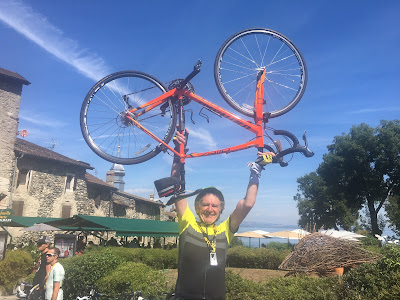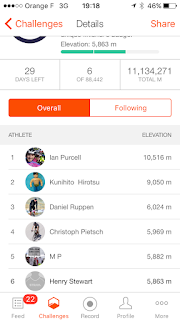 |
| Reaching the top of Galibier with John |
It is now 4 months since I completed the Haute Route Alps, which claims to be one of the toughest amateur cycle races in the world. Seven days, 500 miles, 21 Tour de France cols, 22,000 metres of ascent. And the mountains are calling me back. The plan is to get a team together (Team Happy) to ride the Dolomites version in September 2018.
When we first considered entering, my friend James asked an
experienced coach if the two of us – 57 and 60, of good but not exceptional
fitness – could do it. His answer was “Certainly. As long as you put in the
training, and do the right sort of training – preparing your body for endurance
cycling over several days.”
Like to join us? Here are my tips for getting ready:
1: Get the miles in:
There is no substitute for doing a lot of cycling. I started training 8 months
in advance and cycled over 5,000 miles in that time. Through June and July I
was making sure I rode over 200 miles a week.
This is possible alongside a busy job. Nearly all the cycling was at weekends, with possibly one gym session on a weekday evening.
2: Mountains are a Must:
The biggest climb near me, Muswell Hill or Highgate, is 70 metres. Even after
12 repeat ascents, which we did, we hadn't climbed as much as the first climb on Day 1 of the Haute. So I went further afield. On a five day holiday in Spain, with 20
cycling buddies, I managed 6,000 metres of ascent – which was a huge confidence
boost towards thinking I could do 22,000 metres in 7 days. Plus some good rides
in the peak district, and even a few climbs in Colombia.
 |
| A few hairpins on the way to the top |
3: Doing the miles is
not enough: Marcus Leach, one of our fellow haute riders, put it well when
he said “you have to push your body to its limits to prepare it for this”. That
included intensive spin classes (using the sufferfest videos), going on club rides that were a real challenge for me and repeatedly trying
to beat my Strava times up the local hills.
Others did Yoga or work on their core and whole body
workouts. But above all you’ve got to prepare yourself for long rides and for
climbing, over successive days. That means doing that in your training.
4: Use the gadgets:
I didn’t, and it was a mistake. I discovered that the mind is not a good judge
of the best pace to go at. I’ve now ordered a power meter to attach to my pedal.
You measure your threshold in an intensive gym session and the meter can then
tell you what pace you are able to go at, and keep up for a long climb. (There is a running joke online that Chris Froome spends most of his time looking at the power meter reading on his cycle stem.)
Failing a power meter, heart monitors
come close.
5: Get the nutrition
right: This is different for everybody. But you will use a lot of calories
on your ride (Strava tells me 5,000 per day) and need a hell of a lot of water.
Find a way to get it inside you. Make sure you get a regime that works for you
well practised before the big event – unlike me.
(Everybody’s method is different. In the end I relied on
chicken stir fry the night before, yoghurt, fruit and nuts for breakfast, 30g
of carb per hour in my water, a litre of water – and dried fruit - at every
food station. Plus, from Colombia, Quintana’s secret weapon of passion fruit bocadillos.)
6: Learn to work with
others: Cycling is a group activity. The more you can work together, the
easier it gets. Getting on somebody’s wheel (which means your front wheel being
6 inches or less behind their back wheel) makes it physically 30% easier on the
flat and psychologically easier on the climbs.
Of course you should take turns to be at the front. The best
bits were when we got a good rotation going, with 7 or 8 of us gradually
rotating the lead. That enables you to fly along so much faster than you ever can on
your own.
7: Find your way up
those mountains: Some fellow cyclists have read my blog and been horrified
by all the conversation. “Just shut up and focus on getting up that climb” was one
response. Hey, this is my approach. Cycling up 5,000 ft of mountain, for
two hours or more, takes resolve. Some focus with a grim determination, some
get into a meditative state. I like to chat. It works for me.
8: Its not all about
the bike: I rode on a £600 Specialised Allez, a gorgeous bright orange but possibly
the cheapest and heaviest bike in the race. Others had spent £10,000 or more on
their majestic steeds. The online calculator tells me that the
4kg less weight would mean I’d be 15 minutes quicker each day. That would be
very nice but not the difference between completing and dropping out.
 |
| At the finish, on the shores of Lake Geneva |
9: Have a supportive partner: Possibly the most important factor, as they will no doubt come to see you as a little obsessive, even that they are "married to a bicycle". I am very lucky here. Dawn even asked if I was doing enough training and encouraged me to go off on the extra Peak District training weekend.
10: Enjoy it: This
was the best advice I received. You are in some of the most stunning scenery in
the world doing what one of the activities you love most. Don’t let the
challenge and the focus on a good time get in the way of having a fantastic personal
experience.
Join us?
So could you ride the Haute? Of course you can. You don’t
need to be a top athlete. You just have to be prepared to put the work in
and get all the above elements working together. You could end up feeling fitter and healthier than you ever have before.
Team Happy will get together in 2018 to ride the Haute
Dolomites. We already have 8 people up for it. Will you join us? Email me at henry@happy.co.uk if you are interested.
 |
| With John - from Sydney - at the closing ceremony, I discovered we also shared a taste in shirts. |
 |
| With Arnold from China. He invited me to the Tibet Challenge: 2,000 miles over 10 days, above 4,000 metres. 30 cyclists started and just 6 finished. |

























